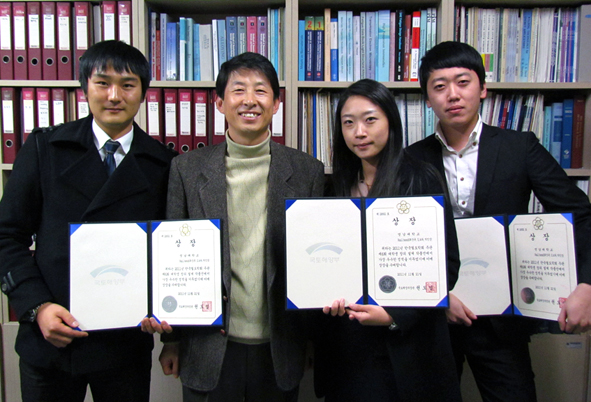Award of Minister of Land, Transport and Maritime Affairs and 1 Million Won Reward
[November 26, 2011]
“We want to contribute to the development of the Korean railroad industry.”
The ‘RailBond’ Team (guidance counselor, Professor Baek, Eung-ryul), which is made of graduate students and undergraduate students of the School of Materials Science and Engineering, was given the award of Minister of Land, Transport and Maritime Affairs, which is the grand prize, at the ‘6th University Student Creative Design Competition’ hosted by the Korea Society for Railway.
Their team is made up of Choi, Sang-gyu (27) and Kim, Bo-ra (25, female), in the Graduate School of Materials Science and Engineering working on their master’s degrees, and Park, Seong-sang (25), who is currently an undergraduate senior in the same school.

RailBond Team and Professor Baek, Eung-ryul (from left to right: Choi, Sang-gyu, Professor Baek, Eung-ryul, Kim, Bo-ra, Park, Seong-sang)
The 6th University Student Creative Design Competition began in 2006 with the goal of providing an opportunity to foster creativity to undergraduate (graduate school) students and commercialize their ideas related to the railroad industry and technologies by the Korea Society for Railway. This year, 30 university teams from around the nation competed and after the initial screening (proposal, presentation plans, photos of works), only eight teams were qualified. Recently, the final judging was made together with an exhibition at the Ramada Plaza Jeju Hotel.
In result, the ‘RailBond’ team won the Award of Minister of Land, Transport and Maritime Affairs and a cash prize of one million won for their ‘thermit welding solution for bonding domestic train rails using recycled metals’. They came up with this idea because with the increasing demand for High-speed rails and metropolitan railways, the demand for rail bonding themit welding materials, which are currently fully dependent upon imports, will also increase. They were able to cut costs and making a domestic thermit welding solution by using aluminum powder generated from discarded aluminum cans and iron oxide generated as by-products from metal industrial sites. In addition, by applying heat-processing techniques, which were not applied in the past, it radically improved the mechanical features of the welded parts to add the strength of preventing damages to the rails.
Professor Baek, Eung-ryul (51, School of Materials Science and Engineering), who provided guidance for them, said, “The item that these students developed took into consideration the academic perspective of establishment of manufacturing technologies on thermit reactants for railways, of which the knowhow was limited to just a few countries, and improved performance, as well as environmental perspectives that recycles aluminum cans, and also economical perspectives that cut costs and localizes it. Therefore, if this is commercialized, it is expected to contribute to the progress of Korean railroad technologies.”
Choi, Sang-gyu, who was the team leader, said, “I would like to give the honor to our team members who worked day and night for two months to prepare for this competition. In particular, there were many difficulties such as that materials related to thermit reaction are not open and rarely revealed by patents and the high cost of testing was needed, but we were able to overcome such difficulties with the full support of Professor Baek, Eung-ryul. I would like to once again thank our professor for his assistance and guidance.”
Kim, Bo-ra said, “Though most people are unaware of the importance of welding, welding is used not only in the railroad sector, but in various industries. There are hundreds of different types. You can stop by our lab anytime to see our diverse welding devices.” She added with a smile, “I hope you show more interest in the welding field.”
※ Thermit: This is a compound that combines aluminum powder and iron oxide powder at an equal amount. When ignited, it emits high temperatures of 3,000℃ and is therefore used for welding steel.










